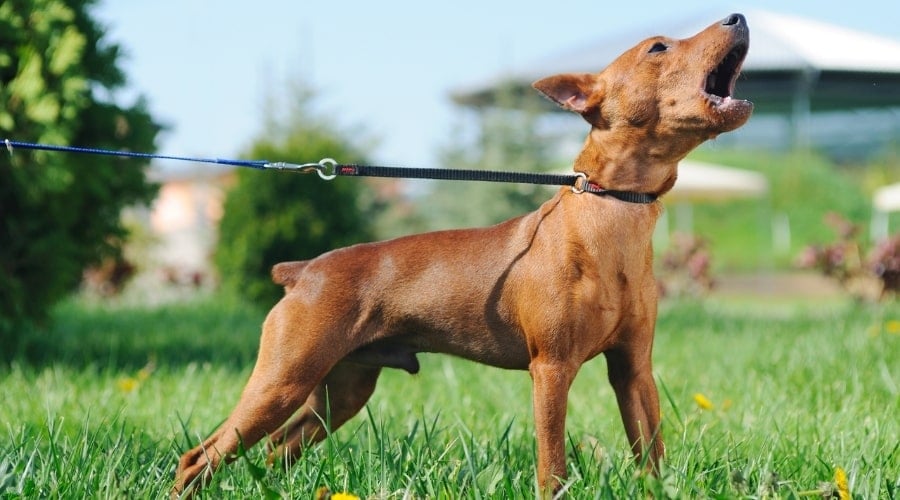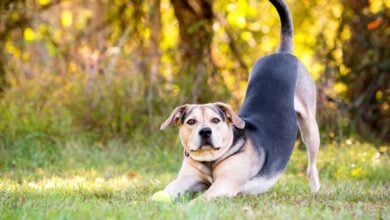What Do Dogs Dream About? The Adorable Truth Will Melt Your Heart
When you purchase through links on our site, we may earn a commission. Here’s how it works.

If you’ve ever watched your dog sleep, you’ve probably seen their legs twitch, their nose wiggle, or even heard a little muffled “woof” escape mid-slumber. It’s like they’re off in some secret doggy dreamland, chasing squirrels, reliving their best zoomies, or maybe even plotting how to finally catch the mailman. Maybe they’re plotting world domination or wondering why you won’t share your sandwich.
Table of Contents
The question on every owner’s mind is, do our dogs dream? And if so, what do dogs dream about? Are they dreaming about you, their favorite toys, or something far more mysterious, like the meaning of life? As it turns out, dogs do dream, and scientists have been studying their nighttime adventures for years. Not only do dogs enter the same dream-filled sleep cycles as humans, but their dreams are probably just as vivid.
So, what exactly is your dog dreaming about? And how can you make sure they have the sweetest dreams possible? Let’s dive into the fascinating, adorable, and sometimes hilarious world of dog dreams. If you thought your pup was cute while awake, just wait until you find out what’s happening in their sleep. If you’ve ever wondered what on earth is going on in that fluffy little head? You’ve come to the right place.
Do Dogs Dream Like Humans? Science Says Yes

Dogs don’t just sleep. They experience complex sleep cycles just like we do. If you’ve ever watched your dog doze off, you’ve probably noticed how their breathing slows, their body relaxes, and eventually, they start twitching or even moving their paws like they’re running. That’s because, just like humans, dogs go through multiple stages of sleep. This includes the all-important REM (Rapid Eye Movement) sleep, the stage where most dreaming happens.
The Science Behind Dog Dreams
Scientists have been studying animal sleep for decades, and their findings are both fascinating and adorable. In a famous study at MIT, researchers monitored rats’ brain activity as they ran through mazes. Later, while the rats were in REM sleep, their brains showed the exact same neural activity patterns. It’s almost as if they were replaying their waking experiences. In other words, they were dreaming about the maze!
Since dogs have even more complex brains than rats, scientists believe that dogs not only dream but that their dreams are just as detailed and experience-driven as ours. Science has also found that a dog’s brain bears a strikingly similar structure to a human’s brain. This is another reason why scientists believe dogs must dream like we do. Essentially, if your dog had an exciting day at the park, chances are they’re reliving those zoomies in their sleep.
How Do We Know Dogs Dream?
All dogs are different, but most dogs share the same tell-tale signs they’re in doggy dreamland. You may notice some quivering and your dog’s eyes moving behind their closed eyelids. The eyes are moving because they are looking through the images in their dream as if they were images in real life. Humans have this same sleep phase known as REM sleep. If awoken during this time, humans almost always say they were dreaming and can recall details about their dream.
When dogs enter REM sleep, you might notice these other behaviors that might suggest they’re dreaming:
- Twitching Or Moving Paws. This could mean they’re “running” in their dream.
- Facial Twitches Or Nose Wiggles. They are likely sniffing something imaginary.
- Tail Wagging. This is a sign of excitement in dreamland.
- Whimpering, Barking, Or Growling. This suggests they’re interacting with something in their dream.
So yes, dogs do dream like humans, but their dreams likely revolve around the things they love most. This could be playing, exploring, eating, and of course, spending time with their favorite people. Watch our very own Bella and Lily dreaming. They were dozing off, and we caught them on camera. Bella is snoozing, but someone is not amused (ahem, Lily).
But that raises another question – what exactly are they dreaming about? Let’s find out.
What Do Dogs Dream About?
Since dogs can’t wake up, stretch, and say, “You won’t believe the dream I had last night,” scientists have had to rely on brain studies, behavioral observations, and a bit of educated guessing to figure out what’s going on inside their sleeping minds. The consensus? Dogs dream about their everyday lives, only better.
Imagine if you could control your dreams. You’d probably relive your best moments, right? Well, dogs seem to do the same. Their dream sequences are likely filled with their favorite activities, like:
- Chasing squirrels (and actually catching them!)
- Going on epic walkies, where they sniff everything without being rushed
- Barking at the delivery person and finally scaring them away
- Reuniting with their favorite humans after a “traumatizing” five-minute separation
- Eating an unlimited supply of treats (no portion control in dreamland!)
- Rolling in the mud with ZERO consequences
- Playing with their favorite dog toys
Do Dogs Dream About Their Owners?
Yes! And if your heart isn’t melting yet, just wait. Since dogs are deeply bonded to their humans, researchers believe they dream about us, just like we sometimes dream about our loved ones. Your dog might be replaying:
- The moment you came home from work and made their entire day
- That belly rub session where you finally got the spot
- Cuddling up next to you on the couch (which is absolutely their couch now)
- That one time you dropped a piece of chicken on the floor – pure bliss
- The delicious homemade meal you made them last year they wished you’d make every night
So if your dog is twitching in their sleep with a happy little tail wag, they’re probably dreaming about their best friend, you.
Do Dogs Dream They Are Running?
Yes! If you notice your dog’s paws twitching, it’s most likely they are pretending to run in their sleep. This is completely normal. If you’ve ever seen your dog twitching, kicking their legs, or even full-on “air-sprinting” in their sleep, they’re probably dreaming about running. Since dogs experience REM sleep (the stage where most dreaming happens), scientists believe they replay real-life experiences in their dreams, just like humans do. And let’s be honest: if your dog has a favorite activity, it’s probably running, chasing, or zooming at full speed.
Do Dogs Have Bad Dreams?
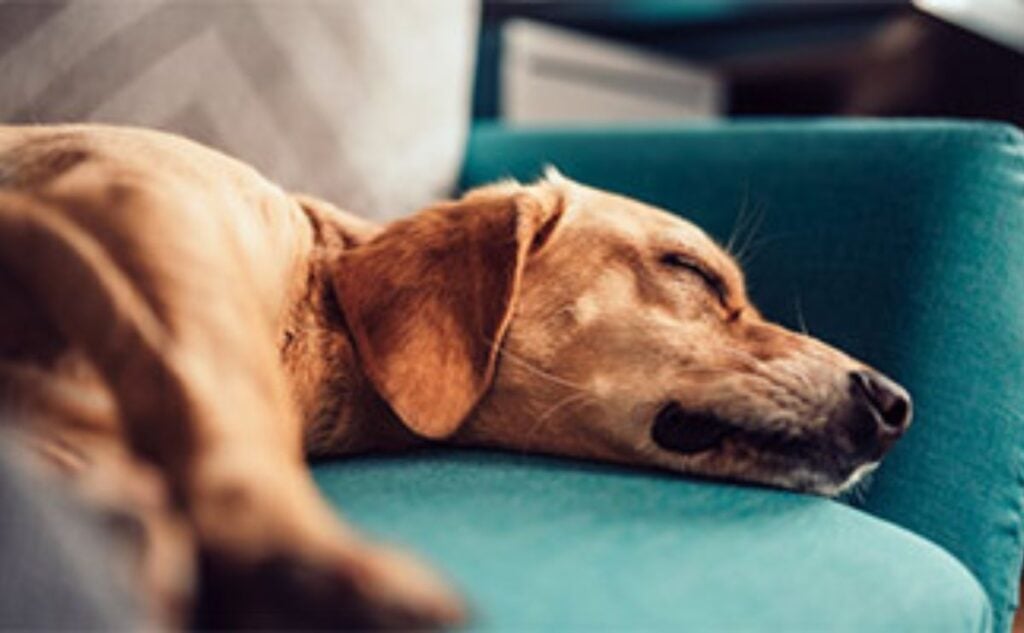
Unfortunately, yes, dogs can have nightmares just like humans. While most dog dreams are probably happy (think endless belly rubs and all-you-can-eat treat buffets), sometimes their brain replays stressful or scary experiences instead.
What Do Dogs Have Nightmares About?
Since dogs dream about real-life experiences, it makes sense that their nightmares are also based on things that scare them. While we can’t ask them directly, we can make some pretty good guesses:
- Past Trauma. If your dog is a rescue, they may relive frightening past experiences, like being in a shelter, experiencing neglect, or being in a bad situation before finding their forever home.
- Trips To The Vet. Let’s be real: no dog enjoys the cold metal exam table, the dreaded thermometer, or the betrayal of a surprise shot.
- Loud Noises. Fireworks, thunderstorms, or even the dreaded vacuum cleaner might appear in their worst dreams.
- Being Left Alone. Dogs are social creatures, and separation anxiety can make them dream about being lost, abandoned, or waiting endlessly for their human to return.
- Bad Interactions. If your dog had a scary run-in with another dog or a person, they might relive that stressful moment in their sleep.
- That One Time You Stepped On Their Paw. They’ve forgiven you, but their subconscious hasn’t.
How Can You Tell If Your Dog Is Having a Nightmare?
Not all sleep movements mean a dog is having a bad dream, but signs of distress include:
- Whimpering, whining, or growling
- Rapid, panicked breathing
- Twitching that looks more like struggling than playful running
- Sudden jerks or flinching
- Waking up suddenly, sometimes looking confused or scared
Should You Wake A Dog Up From A Nightmare?
It’s tempting to wake up your dog when they seem distressed, but it’s usually best to let them wake up on their own. They could be confused or startled. Just like humans waking up mid-nightmare, dogs might be disoriented and react instinctively. If you wake them suddenly, they might snap or jump before realizing where they are. It’s part of the sleep cycle. Even if a nightmare seems scary, it’s usually a normal part of dreaming. Waking your dog repeatedly could disrupt their sleep quality over time.
How To Comfort A Dog After A Nightmare
If your dog wakes up looking anxious or shaken, here’s how you can help:
- Use A Calm, Reassuring Voice. Let them hear your familiar, comforting tone.
- Offer Gentle Rubs. But only if they approach you first.
- Give Them A Favorite Toy Or Blanket. Something familiar can help them settle back down.
- Don’t Reinforce Fear. Avoid making a big fuss, or they might think waking up scared equals extra attention.
6 Ways To Help Your Dog Have Good Dreams
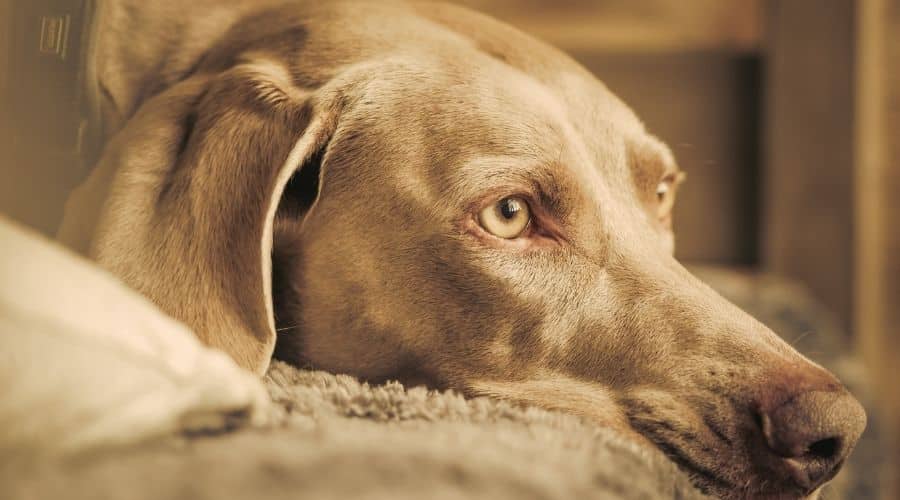
While you can’t control exactly what your dog dreams about, you can help set them up for a peaceful, happy sleep. Just like humans, dogs are more likely to have good dreams when they feel safe, comfortable, and relaxed before bedtime. Here are some of the best ways to help your dog get a restful sleep in doggy dreamland.
1. Give Them Plenty Of Exercise
A well-exercised dog sleeps deeper and longer, which helps them reach REM sleep, which is the stage where dreams happen. Make sure your pup gets enough physical and mental stimulation during the day, whether it’s a long walk, a game of fetch, or puzzle toys that keep their brain engaged.
2. Create A Cozy Sleeping Space
Where your dog sleeps matters! Give them a comfortable, calming bed in a quiet spot where they won’t be disturbed by loud noises or sudden movements. If your dog sleeps in a crate, make it a positive, safe space by adding their favorite blanket or a toy that smells like you.
3. Stick To A Calming Bedtime Routine
Dogs thrive on routine, and a consistent nighttime schedule can help them relax before bed. Try activities like gentle petting, soft words, or a calming chew toy to wind them down. If your dog gets nervous at night, soothing background noise like white noise or soft music can make them feel more at ease.
4. Avoid Stress Before Bedtime
Just like people, dogs can carry stress into their sleep. Avoid high-energy activities or stressful situations (like nail trims or baths) right before bed. Instead, let their last waking moments be positive and comforting so they drift off to sleep feeling happy.
5. Offer A Comfort Item
Some dogs sleep better with a favorite toy, blanket, or even a piece of their owner’s clothing nearby. The familiar scent can reduce anxiety and help them feel safe, leading to happier dreams.
6. Provide A Good Diet & Hydration
Hunger or discomfort can disrupt sleep, so make sure your dog has a well-balanced diet and access to fresh water. However, avoid feeding a large meal or giving too much water right before bed, as a full bladder might lead to midnight wake-ups.
How Often Do Dogs Dream?
Dogs dream multiple times per night, but according to the American Kennel Club, how often they dream depends on their age, size, and sleep cycle. On average, dogs enter REM sleep every 20 minutes, meaning they can have several dreams per night if they’re in a deep, uninterrupted sleep. However, the length and frequency of these dreams vary. Smaller dogs tend to dream more frequently, sometimes every 10 minutes, while larger dogs dream less often, about every 60 to 90 minutes.
Not every sleep session results in a dream, though. Dogs must reach REM sleep for dreaming, which doesn’t always happen during quick daytime naps. Short naps often don’t last long enough for dogs to enter deep sleep, meaning they likely won’t dream at all. However, during long, restful sleep, especially at night, dogs experience more REM cycles and, therefore, more dreams.
Do Puppies & Senior Dogs Dream Differently?
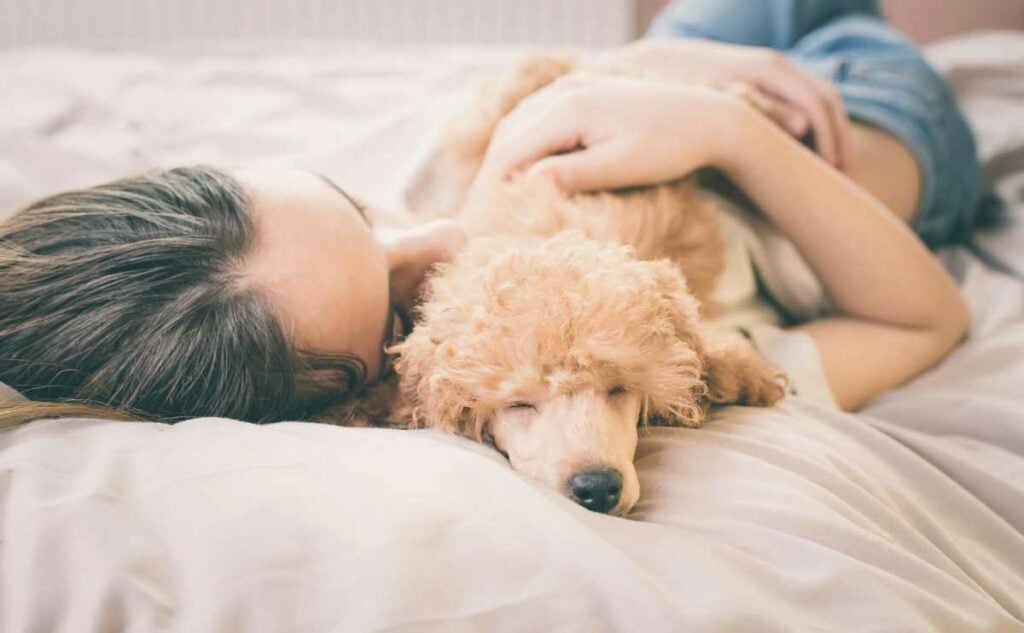
Yes! Puppies and senior dogs dream more frequently than middle-aged adult dogs but for very different reasons. Puppies are experiencing everything for the first time – every sight, smell, sound, and taste is brand new. Their little brains work overtime to process these experiences, which scientists believe leads to more frequent and vivid dreams.
Senior dogs, on the other hand, maybe reminiscing about their youth, reliving their past adventures in their sleep. Think of it like a nostalgia reel, replaying their best zoomies, their greatest fetch victories, or that one time they outsmarted you and stole an entire pizza off the counter.
Puppy Dreams: A Brain Full Of Firsts
Puppies are constantly learning – where to potty, how to play, what a leash is, and why vacuum cleaners are pure evil. Their brains are absorbing and storing information at lightning speed. Since dreams help with memory consolidation, puppies might dream more often as their brains process all their new experiences.
If you see your puppy twitching, paddling their paws, or letting out tiny yips, they might be reliving their latest adventure. Whether it was meeting a new friend or discovering the absolute terror that is a doorstop spring. Their dreams may also help them practice motor skills. So when they’re twitching or “running” in their sleep, they could be refining their coordination for future zoomies.
Senior Dog Dreams: A Walk Down Memory Lane
Older dogs tend to sleep more deeply and for longer periods, which means they have more REM sleep cycles and more opportunities to dream. Scientists believe senior dogs may dream about past experiences, much like humans reminiscing in their sleep. So if your senior pup is wagging their tail in their sleep, they could be dreaming about their puppyhood zoomies or that time they had an all-you-can-eat buffet of stolen table scraps.
You may also notice that senior dogs sometimes wake up confused or disoriented after dreaming. This can happen if they have age-related cognitive changes, like doggy dementia, or if they were deep in a particularly vivid dream.
Learn More About Other Canine Habits
Dogs are full of weird, wonderful, and downright bizarre habits. If you’ve ever wondered why your furry friend has strange rituals, you’re not alone. Crotch sniffing is your dog’s way of gathering information. Eating poop might seem disgusting to us, but some dogs do it out of boredom, nutritional deficiencies, or just because they think it’s a tasty snack (yes, really). And if your dog locks eyes with you while pooping, it’s not because they’re trying to make things awkward, it’s a survival instinct! There’s always more to learn about the strange and hilarious world of canine habits!
Does your dog dream every day? Are you worried they have more bad dreams than good ones? Or maybe you have a funny doggy dream story? We love to hear our readers’ stories, so let us know in the comments below.
Why Trust Canine Journal?
Kimberly has written about various dog-related topics, such as pet insurance, health conditions, treats, training, and more. She consulted with other Canine Journal members to glean their personal experiences with doggy dreams. Kimberly spent over 10 hours researching and writing this article. She works with a dedicated team to ensure Canine Journal maintains its reputation as a trusted and go-to online resource for all things dog.
